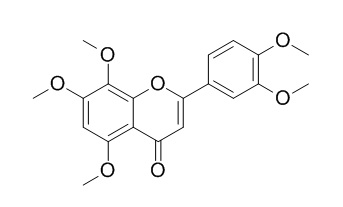Isosinensetin
Isosinensetin shows antioxidant and HIV-1 protease inhibiting activities.
Inquire / Order:
manager@chemfaces.com
Technical Inquiries:
service@chemfaces.com
Tel:
+86-27-84237783
Fax:
+86-27-84254680
Address:
1 Building, No. 83, CheCheng Rd., Wuhan Economic and Technological Development Zone, Wuhan, Hubei 430056, PRC
Providing storage is as stated on the product vial and the vial is kept tightly sealed, the product can be stored for up to
24 months(2-8C).
Wherever possible, you should prepare and use solutions on the same day. However, if you need to make up stock solutions in advance, we recommend that you store the solution as aliquots in tightly sealed vials at -20C. Generally, these will be useable for up to two weeks. Before use, and prior to opening the vial we recommend that you allow your product to equilibrate to room temperature for at least 1 hour.
Need more advice on solubility, usage and handling? Please email to: service@chemfaces.com
The packaging of the product may have turned upside down during transportation, resulting in the natural compounds adhering to the neck or cap of the vial. take the vial out of its packaging and gently shake to let the compounds fall to the bottom of the vial. for liquid products, centrifuge at 200-500 RPM to gather the liquid at the bottom of the vial. try to avoid loss or contamination during handling.
Phytomedicine.2024, 126:155442.
Appl. Sci.2023, 13(17):9984.
Nutrients.2018, 10(12):E1998
Neuropharmacology2019, 151437
Int J Biol Macromol.2020, 169:342-351
The Journal of Agromedicine and Medical Sciences2018, 4(1)
Curr Issues Mol Biol.2023, ;45(2):1601-1612.
Univerzita Karlova2021, 20.500.11956.
Biomed Pharmacother.2024, 171:116166.
Horticulture Research2020, 7:111.
Related and Featured Products
Phytomedicine. 2011 Jan 15;18(2-3):189-93.
Isolation of adenosine, iso-sinensetin and dimethylguanosine with antioxidant and HIV-1 protease inhibiting activities from fruiting bodies of Cordyceps militaris[Pubmed:
20576416 ]
According to previous studies, a close relationship between oxidative stress and AIDS suggests that antioxidants might play an important role in the treatment of AIDS.
METHODS AND RESULTS:
Cordyceps militaris was selected from nine edible mushrooms by assay of inhibition of erythrocyte hemolysis. Macroporous adsorption resin and HPLC were used to purify three micromolecular compounds named L3a, L3b and L3c. L3a was identified to be adenosine with the molecular formula C(10)H(13)N(5)O(4); L3b was 6,7,2',4',5'-pentamethoxyflavone with the molecular formula C(20)H(20)O(7), and L3c was dimethylguanosine with the molecular formula C(12)H(17)N(5)O(5). The compound 6,7,2',4',5'-pentamethoxyflavone was first isolated from C. militaris. The assay of inhibition of HIV-1 protease (HIV-1 PR) was based on the fact that the expression of this enzyme can inhibit the growth of E. coli.
CONCLUSIONS:
This is a new screening system for HIV-1 PR inhibitors. Both L3a and L3b showed high inhibition to HIV-1 PR. These compounds could be new anti-HIV-1 PR drugs.
Toxicol Appl Pharmacol . 2019 Apr 15;369:49-59.
Inhibitory effects of flavonoids on P-glycoprotein in vitro and in vivo: Food/herb-drug interactions and structure-activity relationships[Pubmed:
30790579]
Abstract
Flavonoids are a class of polyphenol antioxygen, despite various known biological activities and therapeutic potential, scattered but not much is known about their interactions with drug transporters. P-glycoprotein (P-gp) as a cellular defense mechanism by effluxing its substrates has been widely investigated. The aim of this study was to investigate the inhibitory effects of 75 flavonoids on P-gp in vitro and in vivo and to illuminate the structure-activity relationships of flavonoids with P-gp. Five flavonoids, including tangeretin, sinensetin, Isosinensetin, sciadopitysin and oroxylin A exhibited significant inhibition on P-gp in MDR1-MDCKIIcells, which reduced the P-gp-mediated efflux of paraquat and taxol and consequently increased their cell toxicity. In addition, co-administration of digoxin with five flavonoids increased the AUC0-t of digoxin in different extents in rats, from 19.84% to 81.51%. Molecular docking assays elucidated the inhibitory effect of flavonoids might be related to Pi interactions, but not hydrogen bonds. The pharmacophore model suggested the hydrophobic groups in B benzene ring may play a vital role in the potency of flavonoids inhibition on P-gp. Taken together, our findings would provide the basis for a reliable assessment of the potential risks of flavonoid-containing food/herb-drug interactions in humans.
Keywords: Flavonoids; Inhibition; P-glycoprotein; Structure–activity relationships.
J Physiol Biochem. 2013 Jun;69(2):239-53.
Oxidative stress-related lung dysfunction by chromium(VI): alleviation by Citrus aurantium L.[Pubmed:
22972417 ]
Chromium(VI), a very strong oxidant, causes high cytotoxicity through oxidative stress in tissue systems.
METHODS AND RESULTS:
Our study investigated the potential ability of ethanolic Citrus aurantium L., family Rutaceae extract, used as a nutritional supplement, to alleviate lung oxidative damage induced by Cr(VI). A high-performance liquid chromatography coupled with a mass spectrometer method was developed to separate and identify flavonoids in C. aurantium L. Six flavonoids were identified, as (1) poncirin, (2) naringin, (3) naringenin, (4) quercetin, (5) Isosinensetin, and (6) tetramethyl-o-isoscutellarein. Adult Wistar rats, used in this study, were divided into six groups of six animals each: group I served as controls which received standard diet, group II received via drinking water K2Cr2O7 alone (700 ppm), groups III and IV were pretreated for 10 days with ethanol extract of C. aurantium L. at doses of 100 and 300 mg/kg body weight/day, respectively, and then K2Cr2O7 was administrated during 3 weeks, and groups V and VI received during 10 days only C. aurantium L. ethanol extract at doses of 100 and 300 mg/kg/day, respectively. Ethanol extract of C. aurantium L. was administered orally. Rats exposed to Cr(VI) showed in lung an increase in malondialdehyde and protein carbonyl levels and a decrease in sulflydryl content, glutathione, nonprotein thiol, and vitamins C and E levels. Decreases in enzyme activities such as in Na(+)K(+) ATPase, catalase, glutathione peroxidase, and superoxide dismutase were noted.
CONCLUSIONS:
Pretreatment with C. aurantium L. of chromium-treated rats ameliorated all biochemical parameters. Lung histological studies confirmed the biochemical parameters and the beneficial role of C. aurantium L.



